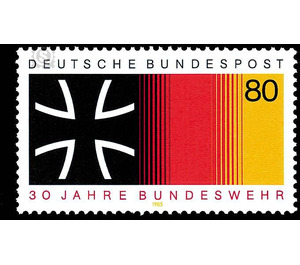30 year sarmed forces Basic ideas of democracy - Germany / Federal Republic of Germany 1985 - 80 Pfennig
Theme: Art & Culture
| Country | Germany / Federal Republic of Germany |
| Issue Date | 1985 |
| Face Value | 80.00 |
| Color | multi-colored black |
| Perforation | K 14 |
| Printing Type | 3-color offset |
| Stamp Type | Postage stamp |
| Item Type | Stamp |
| Chronological Issue Number | 1139 |
| Chronological Chapter | GER-BRD |
| Michel ID | BRD 1266 |
| SID | 740756 |
| In 51 Wishlists | |
Thirty years ago, on November 12, 1955, the first 101 volunteer soldiers of the new German armed forces received their certificates of appointment. This was the 200th anniversary of Scharnhorst's birth, one of the Prussian reformers from 1808 to 1814, whose ideas consciously took up the new military concept. November 12, 1955 is considered the birthday of the Bundeswehr, an army in democracy and the soldier as a citizen in uniform. The two elements »iron cross« and »black-red-gold« symbolize the commitment to the defense worthiness of our liberal constitutional state, the democratic self-understanding of its armed forces and the wounding of people and state in history. The "Iron Cross", designed by Karl Friedrich Schinkel, was built on 10 March 1813 by Friedrich Wilhelm III. donated by Prussia. The occasion was the liberation wars of almost all European peoples against the Napoleonic oppression. With the simultaneous implementation of the German army reform and the introduction of universal conscription, national defense became a matter for all citizens. Pentecost 1832 came at the Hambach Castle near Neustadt an der Weinstrasse to the first democratic mass rally in German history under the colors black-red-gold. From then on these colors became the symbol of the bourgeois freedom movement, which called for "unity, justice and freedom" in a parliamentary democracy. In March 1848 Black-Red-Gold fluttered all over Germany and adorned the Paulskirche in Frankfurt, where on March 18, 1848, the constituent National Assembly met. Black-red-gold finally became the national colors of the Weimar Republic and the Federal Republic of Germany. Article 87a of the Basic Law reads: "The Confederation sets up armed forces for defense". Our soldiers swore and vowed to "faithfully serve the Federal Republic of Germany and bravely defend the right and freedom of the German people." Thus, the mission of the Bundeswehr is described in the shortest but also unmistakable form. (Text: Federal Ministry of Defense, Bonn)
| Condition | Name | In Stock | Price | Price + Shipping | Store | |
|---|---|---|---|---|---|---|
 | Unmounted Mint ** | 30 year sarmed forces Basic ideas of democracy - Germany / Federal Republic of Germany 1985 - 80 Pfennig | 10 | US $1.08 | US $4.32 |  FILATELIELOKET (0) FILATELIELOKET (0)Shipping US $3.23 Minimum Order US $2.70 |


